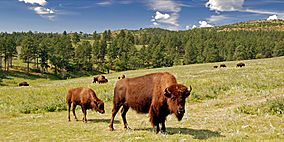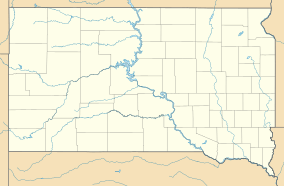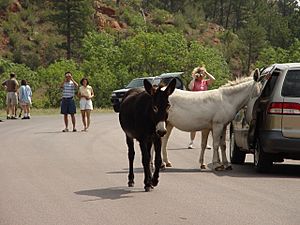Custer State Park facts for kids
|
||||||||||||||||||
Custer State Park is a huge state park and wildlife area in the Black Hills of the United States. It's South Dakota's biggest and first state park. The park is named after Lt. Colonel George Armstrong Custer. It covers more than 71,000 acres (287 square kilometers) of different kinds of land. You'll find rolling grasslands and rugged mountains here.
The park is home to a large herd of about 1,500 bison. Many other animals also live here. These include elk, coyotes, mule deer, white-tailed deer, mountain goats, prairie dogs, bighorn sheep, river otters, pronghorn, cougars, and even feral burros. Custer State Park is famous for its beautiful views and scenic drives. You can take the Needles Highway or the Wildlife Loop. On these drives, you might see the bison herd and busy prairie dog towns. The park is easy to reach by road from Rapid City. Other cool places nearby are Wind Cave National Park, Mount Rushmore, Jewel Cave National Monument, Crazy Horse Memorial, and Badlands National Park.
Park History
Custer State Park started as a small area. But it quickly grew into one large block of land. This happened because the land was challenging to manage in smaller pieces. The park got much bigger in the 1920s. More land was added to it.
In the 1930s, a group called the Civilian Conservation Corps (CCC) helped a lot. They built many miles of roads. They also created parks and campgrounds. The CCC even built three dams. These dams helped create water recreation areas for the future. In 1964, another 22,900 acres (93 square kilometers) were added to the park.
Annual Bison Roundup
Custer State Park holds a special event every September. It's called the annual bison roundup and auction. During this event, the park's bison herd, which has over 1,000 animals, is gathered together. Several hundred bison are then sold at an auction. This helps make sure there are enough plants for the remaining bison to eat. It keeps the herd healthy and the land balanced.
The annual roundups started in 1965. Today, more than 10,000 people come to watch this exciting event each year.
-
Pronghorn at the Wildlife loop road
Park Museums
The Peter Norbeck Center is a special building listed on the National Register of Historic Places. You can find it on U.S. Route 16A in Custer. Inside, you'll find exhibits about the park's nature and history. There are displays showing wildlife scenes. You can also see a bunkhouse from the CCC and a display about gold prospecting. The center is named after Peter Norbeck, who was a governor and senator for South Dakota. Many of the park's nature programs start here.
Badger Hole is another interesting place. It was the home of Charles Badger Clark (1883–1957). He was South Dakota's first Poet Laureate in 1937. He was famous for his cowboy poetry. The house looks just like it did when Clark lived there. Visitors can take a tour of the home. They can also hike the Badger Clark Historic Trail nearby.
A new visitor center opened in May 2016. It has lots of information about the animals in the park. You can also watch a 20-minute film. This film tells the story of the park and shows you what it's like.
Begging Burros
"Begging Burros" is a fun name for the donkeys in Custer State Park. For many years, these donkeys have walked up to cars. They seem to be asking for food.
The Begging Burros live on a hill in one part of the park. There are about 15 of them. They try to get any food they can from visitors. Sometimes, these animals might block the road in Custer State Park. So, it's a good idea to be careful and patient when you see them.






